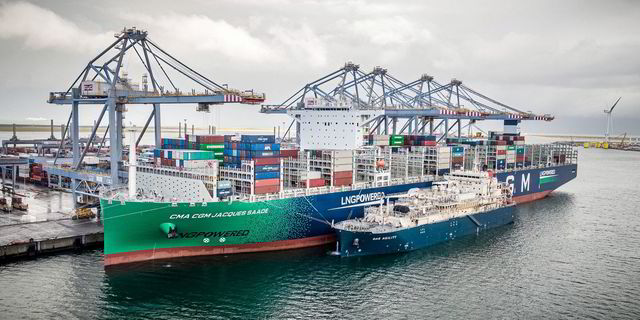French liner giant CMA CGM is reviewing its choice of fuelling for a series of recently contracted midsize container ship newbuildings in China, according to Trade Winds.

Sources familiar with the vessels said talks had been taking place on switching eight methanol dual-fuelled, 9,200-teu boxships to LNG dual-fuelling.
On September 27, 2023, Shanghai Waigaoqiao Shipbuilding(SWS), a subsidiary of CSSC, together with China Shipbuilding Trading Co., Ltd. (CSTC), and France’s CMA CGM signed a contract for the construction of eight 9,200 TEU methanol dual-fuel powered medium-sized container vessels, with a total order price of more than US$1 billion. This order is the largest order of this ship type in the world so far, and Waigaoqiao Shipbuilding has entered the methanol dual-fuel ship market for the first time.
With an overall length of 299.9 meters, a breadth of 45.6 meters, and a capacity of 9,200 TEU, the vessel is classified by the Bureau Veritas(BV), and is the latest generation of environmentally friendly, energy-efficient medium-sized container ship that meets the new requirements of environmental protection and the new needs of the shipping market.
Earlier this year, France’s Duffy Marine Group ordered 10 24,000 TEU ultra-large container ships from Yangzijiang Shipbuilding Group, also powered by LNG. Initially, it was also reported that the order would be methanol-fueled, but the shipping giant finally ” preferred ” LNG fuel, which has a higher degree of market maturity.
Today, with accelerated global decarbonization and increasingly stringent environmental regulations, methanol is increasingly being chosen by shipowners as a potential future marine fuel. While the popularity of methanol fuel has increased, LNG fuel remains the mainstream choice for the shipping industry, given the well-developed infrastructure and the significant progress made in utilizing new technologies to reduce methane leakage from ships.
In the meantime, sustainable fuels such as Bio-LNG and eLNG will become more mature in terms of supply over time, and existing LNG-powered ships can be converted to Bio-LNG and eLNG, meaning that LNG fuels can also help shipowners achieve net-zero emissions in the future. Bio-LNG has a lower carbon footprint than conventional LNG, which is produced from renewable sources such as organic waste and biomass, and existing LNG engines and infrastructure can generally be utilized without major modifications, making it a relatively simple transition.
eLNG utilizes electricity to power the liquefaction process of LNG, usually from renewable sources such as wind or solar. As LNG becomes more widespread, LNG-powered ships are likely to adopt eLNG as a more sustainable option. Notably, eLNG can make use of existing LNG infrastructure, making it suitable for existing LNG-powered ships.


